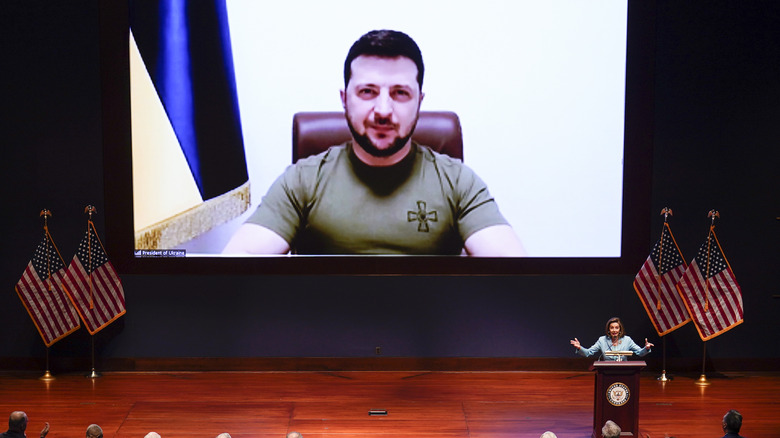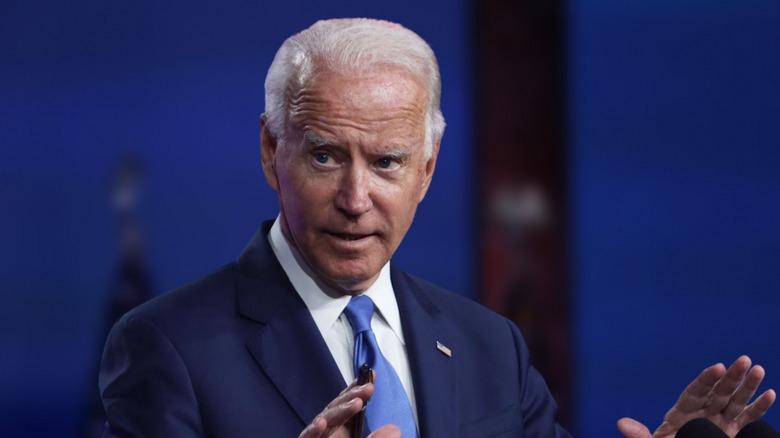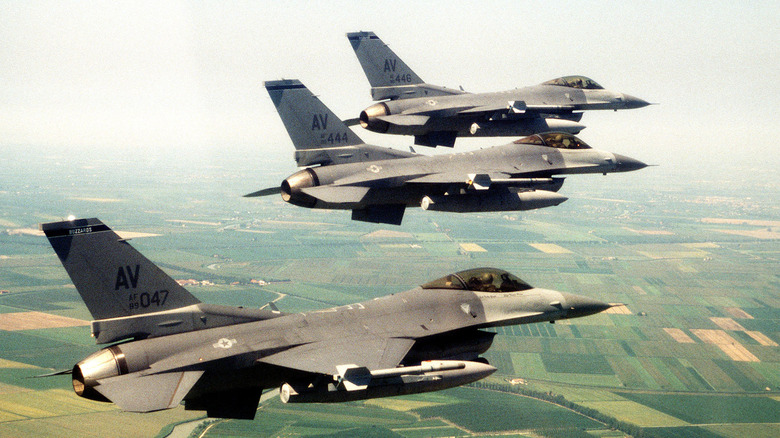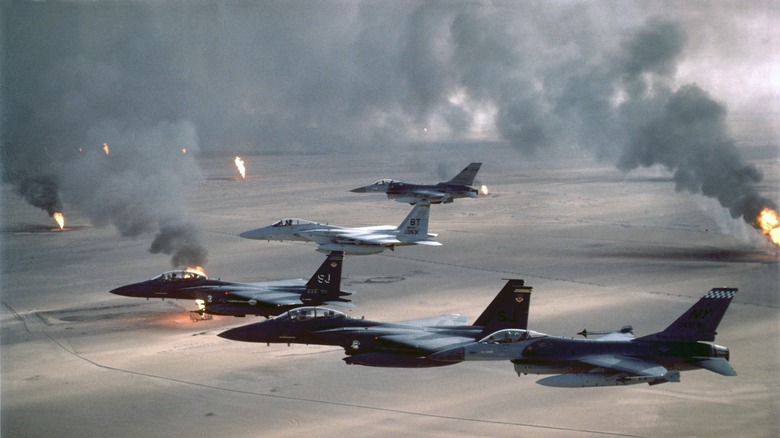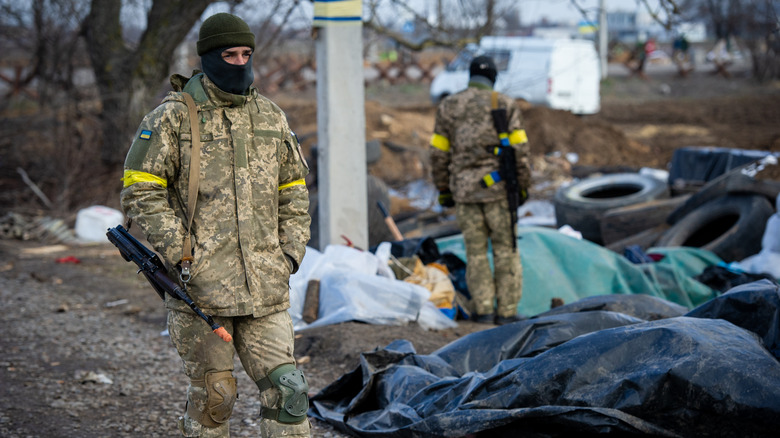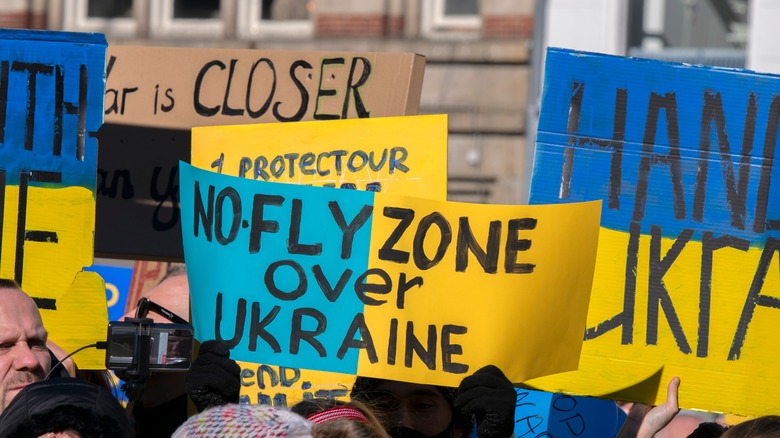What Does A No-Fly Zone Mean And Why Is It Hard To Implement?
A no-fly zone, also known as an air exclusion zone, is an order sent out by a military power that prohibits certain aircraft from flying over a restricted zone, per The Guardian. They are usually established during wars or conflicts to prevent military action and violence in certain areas, typically where there are civilians or sensitive locations. One such zone, for example, was established during the 2012 London Olympic Games to prevent terrorist attacks (per Al Jazeera).
Last week, Ukrainian President Volodymyr Zelenskyy requested additional military assistance from the U.S., asking to create one such no-fly zone in Ukraine to protect against invading forces from Russia after the country targeted a children's hospital in Mariupol (via USA Today). "This is a terror Europe has not seen for 80 years," Zelenskyy said in a virtual address. "Is this a lot to ask, to create a no-fly zone over Ukraine to save people?" Zelenskyy continued.
The US response
Before this virtual address and ever since Russia first invaded Ukraine on February 24 of this year, the Biden Administration has been clear in their position to not establish a no-fly zone in Ukraine. Doing so, they say, could threaten to escalate the situation, per ABC News. In contrast, the vast majority of Americans responding to polls on the matter think differently, and voted in favor of establishing no-fly zones in Ukraine, per Reuters.
In addition, 27 foreign policy experts called upon the U.S. and members of the North Atlantic Treaty Organization (NATO) to establish a no-fly zone over Ukraine in an open letter signed last week. Together, the coalition should "convey to Russian officials that they do not seek direct confrontation with Russian forces," the officials wrote, "but they must also make clear that they will not countenance Russian attacks on civilian areas."
With so many different opinions circling around about whether to establish a no-fly zone or not, it may be helpful to first understand how no-fly zones have been used historically and what we've learned from past implementations.
Historical uses of no-fly zones
Overall, the U.S. has implemented four no-fly zones since The Cold War, per The Conversation. In 1991, the first two no-fly zones were established by the U.S., France, and the U.K. as part of the first Gulf War (via The Conversation). These zones, a part of "Operation Provide Comfort," would last from 1991 to 2003, per The Conversation. Other no-fly zones were authorized in the Bosnian conflict between 1993 and 1995, and in Libya during its 2011 civil war when its dictator Col. Muammar el-Gaddafi was attempting to silence a rebellion (via The Guardian, The New York Times).
Although the first no-fly zone in the Gulf War was established without the support of the United Nations, the U.N. has helped to establish several other no-fly zones since, including the one in 1992 during the Balkans conflict and the 2011 military intervention in Libya, per The Conversation.
Lessons from the past
In The Gulf War, two American planes mistakenly gunned down two fellow American helicopters in 1994, killing all 26 passengers on board (via the Los Angeles Times). In a review of the accident after it happened, the conflict was found to be caused by "a series of misidentifications and misunderstandings," per The Conversation. And that was when the U.S. had entire control of the region, with time to practice procedures pertaining to the no-fly zone. Similarly, a 2004 paper reviewing the effectiveness of a no-fly zone in the Bosnian war found that a clear and unified command structure is essential and that many air forces failed because of confusing dual messaging (via the Journal of Strategic Studies).
Now imagine how that situation differs from the U.S. and NATO establishing a no-fly zone against the Russian military in an active combat zone. Plus, since Russia's invasion of Ukraine, the country has used mostly ground forces to attack Ukrainian targets, which one U.S. defense official said last week were the kind of attacks that would not be helped by a no-fly ban (via The Guardian).
What could go right?
No-fly zones can serve as an intermediary step that allows countries to intervene and help allies without sending in troops on the ground, per The New York Times. In the Persian Gulf War, Iraqi leader Saddam Hussein directed helicopters to shoot at uprisings on the homeland, killing more than 10,000 people. The coalition that established the no-fly ban during this war — which the U.S. was a part of, did so in order to prevent such aerial attacks (via The New York Times).
Although no wars have ever ended because no-fly zones were imposed, they may have reduced violence against Bosnian Muslims and others in the Bosnian war between 1993 and 1995, according to The Conversation. In preventing Russia's air forces from being deployed in Ukraine, it could also allow civilians fleeing the country to do so more safely (per The Guardian). In the Ukraine-Russia conflict, the U.N. estimated that as of March 14, 2022, 636 civilians had been killed, according to Reuters.
What could go wrong?
Critics of the no-fly zone in the Gulf War said that it wasn't legally authorized and that the U.S. airstrikes ended up killing civilians, per The New York Times. Indeed, the nature of no-fly zone restrictions themselves can be violent. Conflict can arise when the countries that enforce the ban shoot down aircraft that violate the space or deploy anti-air defenses.
This violence could escalate things. If a Russian jet were to fly in the no-fly zone and was shot down by a U.S. air defense, it could increase the country's involvement in the war, according to The Guardian. NATO's secretary-general, Jens Stoltenberg has said the coalition has not put a ban in place out of fears that it would cause "a full-fledged war in Europe" (via The New York Times). Russian President Vladimir Putin has warned countries against this, specifically, saying that any country that imposed one such zone in Ukraine would be "participating in the armed conflict," according to The New York Times.
